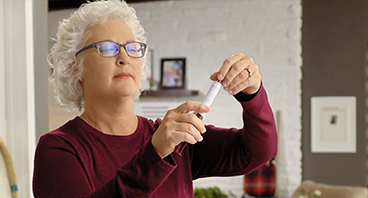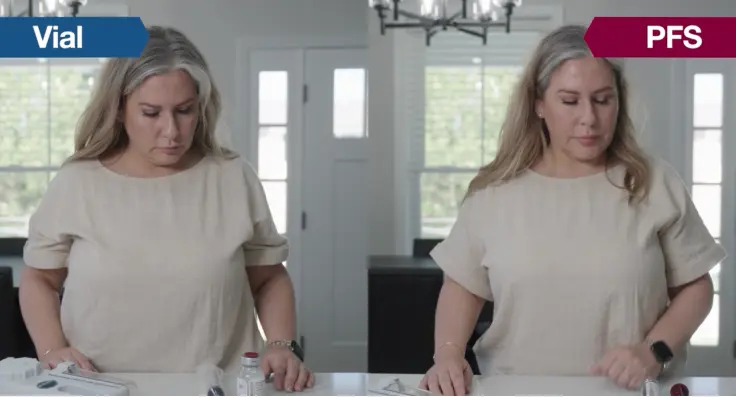CIDP self-administration videos

Self-Administration with Prefilled Syringes
Learn how to self-infuse with Hizentra prefilled syringes

Preparation: Vials vs Prefilled Syringes
See the simplicity of prefilled syringes vs. vials

Explore the many videos available, including real people with CIDP discussing their experiences, Hizentra treatment, and useful support services, as well as videos describing the self-infusion process.

Self-Administration with Prefilled Syringes
Learn how to self-infuse with Hizentra prefilled syringes

Preparation: Vials vs Prefilled Syringes
See the simplicity of prefilled syringes vs. vials

Arthur
Arthur shares how self-infusing with Hizentra Prefilled Syringes provides consistent Ig levels, which help him maintain a more steady level of strength and energy

Stephanie
Stephanie talks about avoiding the ups and downs of IVIg by switching to Hizentra, maintaining functional ability, and the benefits of consistent Ig levels

Patti
Patti celebrates the empowerment and freedom she enjoys after switching to Hizentra Prefilled Syringes

Appolos
Appolos explains switching from finding a vein to finding freedom with Hizentra

Elizabeth
Elizabeth, a healthcare professional with CIDP, who shares her diagnosis and treatment journey

What is CIDP?
Dr. Allen offers a deeper dive into CIDP, and some of the treatment options available
The Copay Support Program helps eligible people with commercial insurance by assisting with out-of-pocket expenses for Hizentra. Most people with commercial insurance pay $0 out of pocket*
Here to help you determine whether Hizentra is right for you: 1 month of free medicine, infusion equipment, and in-home nurse training
This program can help eligible patients continue to receive treatment even if they experience a lapse in third-party private health insurance†
*Subject to terms and conditions of the Copay Support Program. To read the full terms and conditions, visit here. CSL Behring reserves the right to rescind, revoke, or amend the program at any time without notice.
†Enrollment required. Subject to terms and conditions. For the Assurance Program, click here.

Commercial Insurance
Discover the details of medical codes and processes of benefits investigation, appeals and loss of coverage, and hear about resources from one of CSL Behring's Field Reimbursement Managers.

Medicare
Learn about Medicare documentation and coverage criteria and how they pertain to CIDP, including out-of-pocket costs. Presented by a CSL Behring Senior Field Reimbursement Manager and Voice2Voice advocate.
WARNING: Thrombosis (blood clots) can occur with immune globulin products, including Hizentra. Risk factors can include: advanced age, prolonged immobilization, a history of blood clotting or hyperviscosity (blood thickness), use of estrogens, installed vascular catheters, and cardiovascular risk factors.
If you are at high risk of blood clots, your doctor will prescribe Hizentra at the minimum dose and infusion rate practicable and will monitor for signs of clotting events and hyperviscosity. Always drink sufficient fluids before infusing Hizentra.
See your doctor for a full explanation, and the full prescribing information for complete boxed warning.
Hizentra®, Immune Globulin Subcutaneous (Human), 20% Liquid, is a prescription medicine used to treat:
Treatment with Hizentra might not be possible if your doctor determines you have hyperprolinemia (too much proline in the blood), or are IgA-deficient with antibodies to IgA and a history of hypersensitivity. Tell your doctor if you have previously had a severe allergic reaction (including anaphylaxis) to the administration of human immune globulin. Tell your doctor right away or go to the emergency room if you have hives, trouble breathing, wheezing, dizziness, or fainting. These could be signs of a bad allergic reaction.
Inform your doctor of any medications you are taking, as well as any medical conditions you may have had, especially if you have a history of diseases related to the heart or blood vessels, or have been immobile for some time. Inform your physician if you are pregnant or nursing, or plan to become pregnant.
Infuse Hizentra under your skin only; do not inject into a blood vessel.
Self-administer Hizentra only after having been taught to do so by your doctor or other healthcare professional, and having received dosing instructions for treating your condition.
Immediately report to your physician any of the following symptoms, which could be signs of serious adverse reactions to Hizentra:
Hizentra is made from human blood. The risk of transmission of infectious agents, including viruses and, theoretically, the Creutzfeldt-Jakob disease (CJD) agent and its variant (vCJD), cannot be completely eliminated.
The most common side effects in the clinical trials for Hizentra include redness, swelling, itching, and/or bruising at the infusion site; headache; chest, joint or back pain; diarrhea; tiredness; cough; rash; itching; fever, nausea, and vomiting. These are not the only side effects possible. Tell your doctor about any side effect that bothers you or does not go away.
Before receiving any vaccine, tell immunizing physician if you have had recent therapy with Hizentra, as effectiveness of the vaccine could be compromised.
Please see full prescribing information for Hizentra, including boxed warning and the patient product information.
You are encouraged to report negative side effects of prescription drugs to the FDA. Visit www.fda.gov/medwatch, or call 1-800-FDA-1088.
You can also report side effects to CSL Behring's Pharmacovigilance Department at 1-866-915-6958.